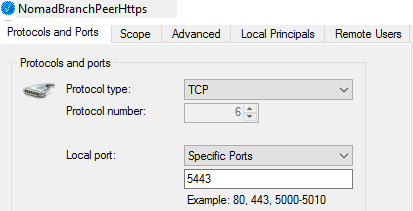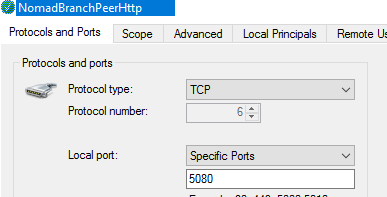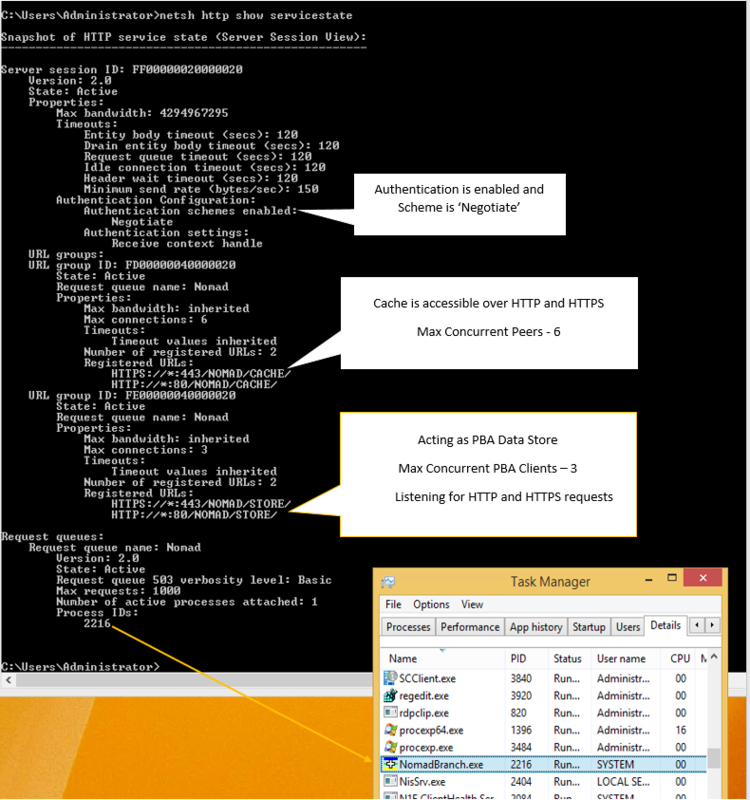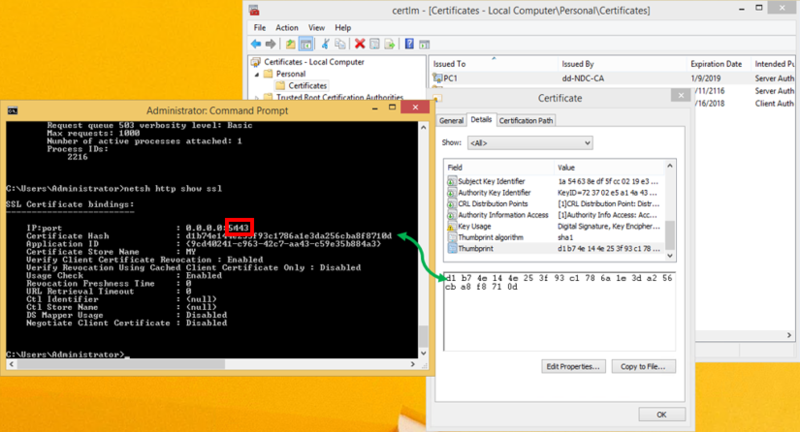Peer copy over HTTP or HTTPS
The product formerly referred to as Nomad has been rebranded as Content Distribution. Although the new name is implemented in the majority of documentation and user interfaces, references to Nomad may still appear in specific tools, scripts, or contexts.
Content Distribution peer-to-peer content transfer uses SMB by default, which requires File and Print services to be enabled in order for it to share the content. For better security Content Distribution can be configured to use HTTP or HTTPS for peer-to-peer content transfer, removing the requirement for file shares. When Content Distribution is configured to use HTTP/S, if Peer Backup Assistant is enabled it will also use HTTP/S.
For some example deployment scenarios and how you can monitor those deployments using the Content Distribution app refer to:
Enabling HTTP/HTTPS
Enabling HTTP/S for peer-to peer content transfer (including Peer Backup Assistant) is done by modifying the relevant bits of the P2PEnabled registry value as shown in the following table:
|
Bit |
Hex |
Decimal |
P2P Protocol used |
|---|---|---|---|
|
0 |
0x01 |
1 |
SMB |
|
5 |
0x20 |
32 |
HTTP |
|
6 |
0x40 |
64 |
HTTPS |
P2PEnabled is a numeric value where, when represented in binary, each bit represents a configurable option, The table above only shows the bits that are relevant to P2P protocol selection. These values can be combined with other P2P settings, refer to P2PEnabled.
It is important to ensure all clients are configured to use the same protocol, as a mismatch in protocol will prevent Content Distribution peers copying content from the elected master. You can enable multiple protocols on a client - for example P2PEnabled = 0x61 enables the peer to connect to the elected master using either HTTPS, HTTP or SMB. In this scenario, the peer will attempt the most secure protocol (HTTPS) first, followed by HTTP and finally falling back to SMB if it is unable to connect using HTTPS or HTTP.
HTTP and HTTPS Ports
When you enable HTTP and/or HTTPS, by default Content Distribution will use port 5080 for HTTP and 5443 for HTTPS, If these ports are already in use in your environment, you can define custom port numbers using the following registry values,
|
Registry value |
Default value |
Notes |
|---|---|---|
|
5080 |
Default HTTP port to use for peer copy. If you are using a custom port, ensure that all Content Distribution clients use the same custom port. |
|
|
5443 |
Default HTTPS port to use for peer copy. If you are using a custom port, ensure that all Content Distribution clients use the same custom port. |
Client authentication
Client authentication is required when Content Distribution peers connect to the elected master. Content Distribution supports two client authentication methods, Windows authentication and certificate-based authentication.
Windows authentication
By default, Content Distribution peers use the local SMSNomadP2P& account, which is created by Content Distribution on each client, to authenticate with the elected master (when the master is elected, it shares a key that enables them to determine the credentials for this local account on the master). This requires each client to allow their local SMSNomadP2P& account to access the computer from the network. Alternatively, Content Distribution peers can be configured to use their Computer Account to authenticate with the elected master using the SpecialNetShare setting. If the Computer Account is used, the Domain Computers group at a minimum must be configured to access the computer from the network on all clients.
By default, the elected Content Distribution master will allow connections from its own SMSNomadP2P& account and all authenticated Users (Authenticated users is required when using the peer's Computer Account to authenticate). You can restrict this further to just the SMSNomadP2P& account using the AuthenticatedUsers setting.
Certificate-based authentication
When Content Distribution is configured to use HTTPS for peer-to-peer content transfer, peers can use a PKI Client authentication certificate to authenticate with the elected master. This is more secure than Windows authentication as it does not require any local accounts to be granted Access this computer from the network permissions. To enable certificate-based client authentication:
-
Configure clients to use HTTPS for peer-to-peer content transfer through the P2PEnabled client setting.
-
Ensure clients have enrolled a client authentication certificate from a PKI in the Local Computer Personal certificate store. (Self-signed certificates cannot be used for client authentication). If you are using Configuration Manager with HTTPS site systems, you should already have a suitable PKI client authentication certificate enrolled on all Configuration Manager clients that Content Distribution can use for P2P client authentication.
-
Optionally (but recommended) configure CertIssuer client setting to assist Content Distribution in selecting the correct client authentication certificate if there are several in the Local Computer Personal certificate store.
-
Configure P2PSslSettings to enable certificate-based client authentication. When this option is enabled, Content Distribution does not create the local SMSNomadP2P& account.
If you enable certificate-based authentication for peer-to-peer content transfer, you must ensure that a valid client authentication certificate is available at all times. If the certificate expires, Content Distribution will return ERROR_CLIENT_CERT_MISSING (0X209A). This error code has been added to the Content Distribution SuccessCodes default setting, which means that Content Distribution will fail the download job and Configuration Manager will not fall back to BITS to download the content from the DP. Content Distribution will not be able to download any content until a valid certificate becomes available on the client.
If you have configured Content Distribution to use a PKI certificate for server or client authentication, when Content Distribution starts it will look for an appropriate certificate in the Local Computer Personal certificate store. In most cases Content Distribution will be able to select an appropriate certificate without any additional configuration. In some cases you may need to specify CertIssuer and possibly CertSubject.
Client authentication certificate selection
Content Distribution will select a client authentication certificate for peer-to-peer authentication from the Local Computer Personal certificate store using the following criteria:
-
If the first certificate is issued by one of the issuers specified in CertIssuer but the next certificate is not, then the first will be selected. If both match or do not match the CertIssuer, then the next step is evaluated.
-
If the first certificate has a subject specified in CertSubject but the next is not, then the first will be selected, otherwise the next step is evaluated.
-
If the first certificate has a subject specified as an FQDN and the second does not, the first will be selected, otherwise the next step is evaluated.
-
The certificate with the latest expiry will be chosen.
Content Distribution will select the first certificate that matches the above criteria. CertIssuer should only be required if the Configuration Manager client is using a self-signed certificate for client authentication with Configuration Manager site systems and there are certificates from multiple Certificate Authorities. When CertIssuer is defined, Content Distribution will select the first certificate issued by that CA that matches the other criteria.
Content Distribution also requires a client authentication certificate for authenticating with Configuration Manager HTTPS Site Systems. In most cases, it will use the same certificate for authentication with peers and Configuration Manager site systems, which will typically be the PKI-issued Configuration Manager client authentication certificate. If for any reason a different certificate should be used for authentication with Configuration Manager site systems, you can additionally specify CertSubject.
Caching of certificates
Once a certificate is selected using the above criteria, it is cached and is provided for any subsequent client certificate requests until the certificate is expired or no longer present in store. Once the certificate is expired or no longer present, another certificate is chosen by using the above selection criteria.
Exception
If the registry value thumbprint is specified under HKLM\Software\1E\NomadBranch\Platform then the certificate with this thumbprint will be chosen (if it is valid, if not then the above selection criteria is used) if the download URL is a background channel URL or if both registry values CertIssuer and CertSubject are not specified.
Missing or invalid client authentication certificate
If Content Distribution is unable to select a valid client authentication certificate for any reason (for example if no certificate present, or is expired, or the certificate is not from the specified issuer), then Content Distribution returns ERROR_CLIENT_CERT_MISSING(0x209A) for the download job. This error code is included in the default SuccessCodes, so if it occurs, Configuration Manager will not revert to downloading using BITS, thereby protecting the network from potential congestion.
-
In Windows PE, Content Distribution fails the job immediately.
-
In the full OS, Content Distribution retries every 10 minutes until a valid client certificate is available in the Local Computer Personal certificate store or timeout (defined by P2PClientCertWaitPeriodMins, 24 hours by default) occurs.
-
If a client certificate becomes available before timeout occurs, a new election is initiated and Content Distribution tries downloading the content again.
-
If no certificate becomes available within the timeout period, Content Distribution will fail the job.
-
During the timeout period, if the Content Distribution service is reset, the download job is paused or the system goes to sleep, Content Distribution will continue to wait for the timeout period to expire. Any other interruption (the for example, if Content Distribution service is stopped, or the download job is cancelled or expires) will cause the download job to fail with the appropriate error condition.
-
While the download job is waiting for a valid client certificate, Content Distribution will not process any other download jobs.
-
Server authentication
Server authentication is required when Content Distribution is configured to use HTTPS for peer-to-peer content transfer. In this scenario, Content Distribution binds a server authentication certificate to the HTTPS endpoint to secure the communication between the elected master and peers. This certificate can be generated either by Content Distribution (self-signed) or through a Public Key Infrastructure (PKI). Use the P2PSslSettings to configure Content Distribution to use either self-signed (default) or PKI certificate.
Server authentication certificate selection
Content Distribution will select a server authentication certificate in the Local Computer Personal certificate store using the following criteria:
-
Store = MY (the default certificate store).
-
Usage = Server Authentication.
-
Subject/DNS = Host name or FQDN.
-
Valid (NotBefore is in the past) and not expired (NotAfter is in the future).
-
Issuer = CertIssuer (Optional).
In most cases, the built-in criteria are sufficient to determine a single applicable certificate. If multiple certificates are likely to match these criteria, you can optionally specify CertIssuer to limit the certificates that Content Distribution will consider to those issued by one or more specific Certificate Authorities. Note that CertIssuer also affects the selection of the Client Authentication certificate. If the server and client authentication certificates are issued by different Certificate Authorities, you can specify multiple CAs with CertIssuer, either using a sub-string that is common to the desired CA names, or a comma-separated list of CA names.
If multiple certificates match the criteria above, Content Distribution uses the following order of precedence when matching the Subject Name:
-
Hostname and FQDN.
-
Hostname.
-
FQDN.
If a single certificate matching the criteria still cannot be resolved, the matching certificate with the longest validity is used.
-
When using Net literal names (3rd bit in P2PEnabled is set), clients ignore mismatch in host names during the SSL handshake – this is because IP addresses are generally not included in certificates.
-
When using self-signed certificates for server authentication, clients do not validate the certificate issuer since it is issued by NomadBranch and it is not a valid CA.
-
Due to the nature of how proxy servers can be implemented, some of which can be quite complex, you may need to consult your networking specialist to see if exceptions need to be added to enable Content Distribution’s peer-copy over HTTP or HTTPS.
Firewall exceptions
Depending on your preferences (protocols, ports) during installation, the installer will add the exceptions to Windows firewall. If for some reason these exceptions are removed post-installation, Content Distribution service will automatically re-add them. You'll just have to restart the service. Content Distribution service checks and fixes required firewall exceptions whenever it starts.
You can verify these in its Inbound Rules:
Firewall exceptions are added against the program system not NomadBranch.exe. This is because Content Distribution uses Windows HTTP Server API to create the HTTP server and under this API all requests are handled by Windows kernel's system program not by Content Distribution directly. In some third-party firewalls you may have to use the program name ntoskrnl.exe, since system is actually an alias for ntoskrnl.exe.
Windows PE support
When running in Windows PE, Content Distribution can download content from peers over HTTP/S, but is not able to serve content to others (a Windows PE client will not be elected as a master). However, Content Distribution still needs to be configured correctly (port usage and certificate type) or it will not be able to connect peers.
Certificate-based P2P Client Authentication in Windows PE
When Content Distribution is configured to use certificate-based client authentication for peer-to-peer content transfer, to support running in Windows PE you will need to update the Windows PE boot image(s) to include a client authentication certificate in the Windows PE boot image (as Windows PE will not be able to enrol a Client Authentication certificate, typically done through Active Directory). If you are using PXE Everywhere and have prepared boot images using UpdateBootImage with a PKI-issued client authentication certificate, no further action is required. If you are not using PXE Everywhere, or have prepared boot images using a Configuration Manager self-signed certificate you will need to update your boot images to use a PKI-issued Client Authentication certificate.
If Configuration Manager is using PKI-issued certificates for Client Authentication, you can use (export) the certificate that Configuration Manager will have already prepared for use with boot images. If Configuration Manager is using self-signed certificates, you will need to export a suitable PKI-issued Client Authentication certificate. In either case, you will need to export the appropriate certificate and provide the path to the exported certificate in the UpdateBootImage UI / command line. Even if you are not using PXE Everywhere, you can use the UpdateBootImage tool by installing just the PXE Everywhere Admin Tools on a device that has the Configuration Manager console and Windows 10 ADK (version corresponding to the version of Windows PE you are using for your boot images). You can download PXE Everywhere from the 1E Support Portal.
Certificate-based P2P Client Authentication in the full OS
When a Task Sequence reboots from WinPE into the full OS, Content Distribution will usually fail to find a certificate in the Microsoft certificate store. This is not an issue. Default logging level logs this fact, but does not show that Content Distribution successfully gets the BootImage certificate which the Task Sequence had previously stored in its variables list while in WinPE. Content Distribution uses this BootImage cert to authenticate with peers, and also with the Background Channel proxy to read data from Content Distribution if SSD is enabled and required. The log goes on to show the Peer Connected OK and gets the content.
Whilst Nomad Branch and 1E Client are separate services, Content Distribution depends on 1E Client to post events via the 1E Switch. However, the Client connection to the Switch depends on finding a certificate in the Microsoft certificate store, which does not exist, and 1E Client logs this error (not in the Nomad log). The 1E Client is unable to use the BootImage cert that Content Distribution uses. Inability to post events while the Task Sequence is running is not an issue, and any errors logged should not be of any concern. When the Task Sequence completes, your normal process of certificate enrollment will complete and the 1E Client will connect to the Switch and the backlog of Content Distribution events will be posted.
Whilst unnecessary, if you want Content Distribution events to be posted sooner in full OS, you can modify your Task Sequence to enrol a certificate into the Microsoft certificate store earlier. One method is to add a step to enable AutoEnrollment after 1E Client (and Content Distribution) is installed.
For example, a Run command-line:
reg add HKEY_LOCAL_MACHINE\Software\Policies\Microsoft\Cryptography\AutoEnrollment /v AEPolicy /d 7 /t REG_DWORD /f /reg:64Configuring Content Distribution to use HTTP/S in Windows PE
Content Distribution uses a custom Install and Configure Nomad in WinPE Task Sequence step to install Content Distribution after the Task Sequence has booted into Windows PE. The settings highlighted below are related to configuration for HTTP/S.
-
P2PEnabled must be set to include HTTP or HTTPS. By default, this is set to 0x9, which disables HTTP/S.
-
P2PHttpPort is disabled unless HTTP is enabled (bit 0x20 set in P2PEnabled). It defines the port that is used for Content Distribution P2P communication over HTTP (default 5080).
-
P2PHttpsPort is disabled unless HTTPS is enabled (bit 0x40 set in P2PEnabled). It defines the port that is used for Content Distribution P2P communication over HTTPS (default 5443).
-
Use PKI cert for client auth enables certificate-based client authentication, which requires a PKI-issued certificate. Selecting this option sets bit 0x2 of P2PSslSettings.
-
Use PKI cert for server auth configures Content Distribution to use a PKI certificate for server authentication when HTTPS P2P is enabled (bit 0x40 set in P2PEnabled). If this option is not checked and bit 0x40 in P2PEnabled is set, Content Distribution will use a self-signed certificate for server authentication.
Configuring use of PKI-issued certificates post-installation
If Content Distribution was originally installed to use HTTPS with self-signed certificates for server authentication and you want to switch to using PKI-issued certificates, do the following:
-
Deploy the certificate to all Content Distribution clients. Ensure that the certificate's usage is Server Authentication and the certificate Subject is the client's host name or FQDN.
-
Enable HTTPS (Bit 6 - 0x0040) in P2PEnabled.
-
Update CertIssuer with the name of the certificate authority.
-
P2PSslSettings set to 1 to enable PKI certificate for server authentication.
-
Restart the Content Distribution service.
Checking the status of your Content Distribution P2P HTTP server
-
To check the status of the P2P HTTP server, open the NomadBranch log. When the Content Distribution service starts, it logs a list of URLs it listens to, as shown.
-
Alternatively, run NETSH to check the status of the P2P HTTP server, as shown.
Checking SSL certificate bindings
-
To check the bindings of your SSL certificates, open the Nomad log. When the Content Distribution service starts, it logs the name of the certificate and its issuer, as shown.
-
Alternatively, run NETSH to check the bindings for the certificates. In our example, the bindings for port 5443 are shown.
Troubleshooting failures during HTTP/HTTPS downloads
The most likely causes of HTTP/HTTPS download failures occur during a connection to a master. The most common errors are detailed below.
|
Error codes |
Reason |
|---|---|
|
0x00002efd 0x00004CF |
HTTP/HTTPS is not enabled on the master or HTTP/HTTPS server on the master is listening on different port. In our example, the log illustrates that HTTPS had not been enabled on the PC1 master. Possible solution: Double-check the values of P2PEnabled on both the client and remote peer - they should be the same. |
|
0x00002f8f 0x000000A |
Invalid Certificate on master. In our example, issues with certificates causes the download to fail with 0x00002f8f (security error) and the logging does not identify the cause of the failure. Where errors like this occurs, check the following on master:
|








